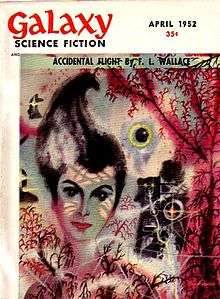Address: Centauri
 Dust-jacket from the first edition | |
| Author | F. L. Wallace |
|---|---|
| Cover artist | Ed Emshwiller |
| Country | United States |
| Language | English |
| Genre | Science fiction |
| Publisher | Gnome Press |
Publication date | 1955 |
| Media type | Print (Hardcover) |
| Pages | 220 pp |
| OCLC | 1850623 |

Address: Centauri is a science fiction novel by author F. L. Wallace. It was published in 1955 by Gnome Press in an edition of 4,000 copies. The novel is an expansion of Wallace's story "Accidental Flight" which first appeared in the magazine Galaxy Science Fiction in 1952.
Plot introduction
The novel concerns people with incurable injuries and defects (biocompensators) who volunteer for the first interstellar flight.
Characters
- Docchi - Formerly an electrochemical engineer, an accident mangles him and tosses him into a tank of cold lighting fluid. He survived but the accident left him armless. The fluid also permeated his system, causing him to glow.
- Nona - Essentially a living computer. Cannot comprehend spoken language.
- Jordan - Half man, his lower torso was severed in an accident.
- Anti (Antoinette) - Ballet dancer who crashed on Venus. Her body was permeated by a Venusian fungus that causes a symbiotic overgrowth of tissue.
- Doctor Cameron - Medical doctor and administrator for Handicap Haven.
- Maureen - Her body lacks the glands to produce male hormones.
- Jeriann - Unable to drink. Gets fluid through absorption capsules.
Summary
Turned down by the medical authorities, they are refused after they steal a ship to plead their case directly to the people of Earth. Returning to their asteroid hospital, they rig a working gravity drive and escape from the solar system. They head towards the Centauri system, solving problems such as overcoming a limited supply of needed pharmaceuticals and improving the drive. Earth sends out a ship, the Star Victory with a better version of the new drive in a bid to beat them there, on the theory that any aliens they encounter might make the mistake of thinking of them as normal humans. The Victory does beat them by a few days, arriving a year after they left, but they settle on a Mars-like planet near Alpha Centauri, before the Victory makes contact with butterfly-like aliens on a methane gas giant in the Proxima Centauri system. The aliens are somewhat similar in technology, but lacking a reliable gravity drive. They want a reasonable sampling of humans to study, but the crew of the Victory are all specialists and they are not welcome. The victory leaves the system to the Accidentals, promising to return, someday.
Reception
Anthony Boucher dismissed the novel as "pretty lifeless fiction, in which both prose and characterization emerge directly from the machine, untouched by human hands."[1]
Bibliography
- Title: Address: Centauri
- Author: F. L. Wallace
- Format/binding: Hardcover
- Edition: First Edition
- Binding: Hardcover
- Publisher: Gnome Press
- Place: New York
- Date published: 1955
References
- Chalker, Jack L.; Mark Owings (1998). The Science-Fantasy Publishers: A Bibliographic History, 1923-1998. Westminster, MD and Baltimore: Mirage Press, Ltd. p. 304.
- Tuck, Donald H. (1978). The Encyclopedia of Science Fiction and Fantasy. Chicago: Advent. p. 443. ISBN 0-911682-22-8.
External links
- Accidental Flight at Project Gutenberg
- Address: Centauri title listing at the Internet Speculative Fiction Database